THE MONKEY WITH THE DRUM. INSIDE NIGERIA'S PRIMATE PARADISE
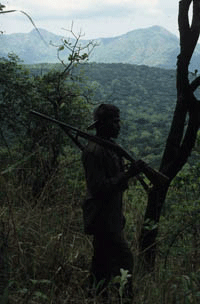
by Volker Sommer
(Director, Gashaka Primate Project; this story was written in 1999)
Salamu seals his lips with a finger. We duck between bushes, trying to sneak up to "biri mai ganga" - "the monkey with the drum". Chimpanzees earned this nickname because, for brief staccatos, they beat buttress roots of trees with hands or feet - perhaps to signal social status. But the jungle seems bewitched. The drumming sounds as if from a neighbour's garden - and yet no ape is seen.
Salamu has an uncanny ability to read the forest's minute signs - be it vegetation trampled by giant forest hogs, footprints of yellow-backed duikers, the droppings of civets or the worrisome humming from a hive of wild bees. Once an infamous poacher, he converted long ago to a gamekeeper. However, Salamu still treks chimpanzees as if on a hunt: shotgun shouldered, moving quietly, cutting through undergrowth with knife and machete. I therefore propose to be less secretive next time - since chimps have every right to be wary if armed humans sneak up to them.
Nests Don't Run Away
The haystack in which we search for needles is called Gashaka-Gumti, with almost 7,000 square kilometres Nigeria's largest national park. Fortunately, chimpanzees leave plenty of indirect evidence: nests in the canopy. They do, like all great apes, construct a stable structure for the night and often a less sophisticated day nest. Brown leaves of old resting places - easily detected against the backdrop of forest green - reveal how many chimps roamed together: here three, there eight, here thirteen. We don't know why the chimps choose certain locations above others. Nests are typically built in relatively tall trees with smooth trunks. Are these more difficult to climb for leopards? Do they simply provide the best view towards nesting neighbours? Are they conveniently placed near food sources?
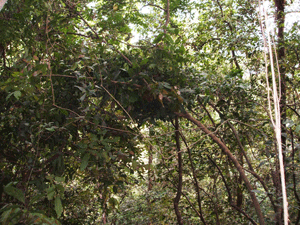
Another possibility is that selected trees feature particularly elastic branches that can be easily knotted into a really comfortable bedding. Salamu pushes from below so that I can climb up towards a low lying nest. Indeed: foliage and twigs are meshed together into a thick mattress. Perhaps those scientists are correct who see a desire for comfort at the heart of nest building activity - since only a peaceful sleep provides mental fitness for the day ahead.
In any case, nests are a gold mine for geneticists. Biologists from the USA have analyzed shed hairs recovered in nests and could establish that Gashaka chimpanzees are so different from other populations to justify status as a separate, fourth subspecies: Pan troglodytes vellerosus.
Thus, a lot can be learned about chimpanzees without ever seeing them. We can also reconstruct their moving pattern using nest counts. During our expeditions into the forest I wanted to map the exact location of nests via GPS. We practiced religiously with our hand-held "global positioning system". But now, under a dense canopy, most efforts are in vain: no reception.
Back in camp. Luca, the cook, shows interest in the GPS, prompting me to explain the instrument's function. My somewhat patronizing efforts earn Luca's laconic response: "The GPS won't work in dense forest. It needs to pick up signals from at least three satellites. And typically, there will be a tree trunk or dense canopy in the way..."
Adding to my embarrassment, Luca asks if we did at least see the chimpanzees? He maintains that two apes strolled through camp before munching on vegetation near the creek. I am reluctant to believe his story. But Salamu confirms the report when investigating ginger near the spot which Luca points out. Yes, the pith was harvested in a chimpanzee typical fashion.
West Africa's Best Kept Secret
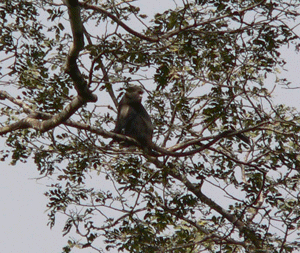
Luca gained his expertise as an assistant to a project of the "Nigerian Conservation Foundation", a non-governmental organization that supports the park administration in developing infrastructure. Research in this really remote location will, at least in its initial stage, likewise depend on logistic support provided by NCF - such as access to four-wheel drive vehicles and workers from the surrounding communities.
This vast border area with Cameroon became a game reserve in 1972 and one of Nigeria's eight national parks in 1991. It is one of the best-kept secrets of Western Africa. Elephants, lions, giant eland - the worlds largest antelopes - and packs of wild dogs roam its dry savannas; hippopotamuses, crocodiles and otters inhabit swamps and mighty rivers. Those hiking beyond the montane forest - rich in ferns and orchids - into the grasslands will reach the fog-shrouded Chappal Waddi, with almost two-and-a-half-thousand meters Nigeria's tallest peak.
For our survey, we concentrate on the gallery forests and lowland rainforest near Gashaka - one of the last terrains in West Africa where primates survive in large numbers. The vegetation resonates with barks of "gogo" (Hausa for Olive baboons), deep "boom" calls of "gimchiki" (Mona monkeys) and the strange dawn choruses of "biri mai roro" - the aptly named "monkey-who-calls" (Black-and-white guerezas). Nearby, "bakin biri" (Putty nosed guenons) and "kiri kaa" (Tantalus monkeys) feast on caterpillars.
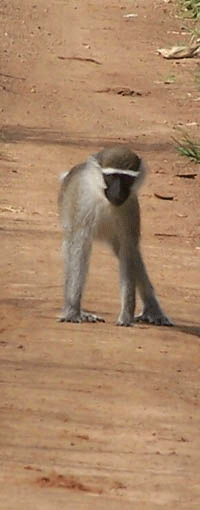
Our premier interest, however, belongs to "biri mai ganga", the "monkey with the drum". Millions of chimpanzees inhabited 25 African countries 50 years ago. Today, they are extinct or close to in at least 10 nations. The remainders will hardly face a better future. Chimpanzees hang on to a handful of enclaves in Nigeria. Long-term survival will probably be restricted to the core area of the national park near Gashaka. One of the reasons is that local Muslim people do not eat primate meat. I ask Salamu to aim his barrel at some monkey groups, a move that elicits curious looks. Elsewhere, they would dive into hiding. The Gashaka monkeys simply don't know what a gun is.
For how long, however, will this primate paradise survive? Our closest living relatives are almost everywhere pushed to the brink. Pitiful remnants of formerly pristine habitat remain scattered amongst farms, plantations and overgrazed land. Roads eat their way through last chunks of continuous forests to allow logging and mining, while fires, wars and streams of refugees add to the strain.
The unbridled consumerism of the rich countries of the Northern hemisphere fuels the widespread destruction. Chop-sticks for Japanese restaurants are cut from trees in which monkeys used to climb; organic insecticide is harvested on land where mountain gorillas roamed previously; diamonds are dug up in the home turf of bonobos, the central couvette of the Congo basin; and German firms chop down chimpanzee forests to obtain timber for designer furniture. Such indiscriminate exploitation is not only short-lived, but also short-sighted because the native human populations will face a hefty bill due to erosion, floods and droughts, pollution, poverty and the immeasurable loss of biodiversity.
The most severe threat to primates comes from the trade in bushmeat that Africans treasure as a delicacy. For this, all wildlife is mercilessly butchered. Markets along the 1300 km road that I drove from Lagos to Gashaka, however, offered at best cane rats, bats or snails - proving that unprotected areas of Africa's most populous nation are already devoid of larger animals.
First Contact
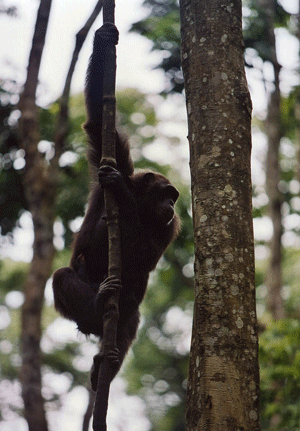
I was thus pleasantly surprised to discover an island of hope once I arrived in Gashaka. From the village, porters hauled our camping gear 15 km uphill, through rivers and shady forests, right into the chimpanzee range.
Today - after one week of fruitless attempts - we decide on a more bold approach. Salamu leaves gun, knife and machete behind in the camp. We head towards the distant calls of chimpanzees. Some hours of hiking follow, up and down steep slopes, through river beds and undergrowth, while we try to keep track of the rowdy ape party somewhere ahead of us.
Finally, around noon, calls and drumming appear close. I believe to hear my own heart-beat, too. Salamu can't help it but instinctively ducks as soon as he makes out five, six black dots up in a tree. But this time we won't hide. Instead, we keep on talking in soft voices and pretend to chew on leaves.
The chimpanzees have, of course, noted us already. We approach the party slowly until we are just 30 meters away. A black face fills the view finder of my binoculars. A female chimpanzee scrutinizes us - somewhat annoyed, perhaps, but certainly without fear or panic. Salamu can hardly believe that the chimps don't flee. It seems as if our strategy paid off.
Half-eaten fruit plunge to the ground. A little chimpanzee plays daring-do in the branches, braving ever more inquisitive excursions away from her mother. There are also two fully-grown males that encircle us. They hurl rocks, shake branches, drum on buttress roots. If they wanted to intimidate us, they have surely succeeded with me - not least, because the Gashaka chimpanzees are much bigger than I imagined. They are truly beautiful, metallic black fur wrapped around impressive parcels of muscle.

I study wild primates since decades - but the human-like appearance of these chimpanzees stuns me. I can't quite shake the feeling that I watch a yet unknown tribe of people. That is true in several ways. For example, humans and chimpanzees shared a last common ancestor 6 million years ago. Just about 30.000 generations have passed, since the split occurred - very little time in evolutionary terms.
Like humans, who are famous for the behavioural diversity they display across populations, apes also have different "cultures" in varying parts of Africa. A seasoned chimpanzeeologist can place an ape community in a certain geographical region, if provided with information about the pattern of behaviour present or absent in that group.
We know nothing yet about the cultural repertoire of the Gashaka chimpanzees. They are a white spot on the map of cultural primatology - and that makes the prospect of research with them so exciting. What might these apes reveal to us once we succeed to study them? Do they communicate in a different vocal dialect than their relatives in Tanzania or Gabon? Will they perform the mysterious rain dance when Atlantic clouds release their wet loads? How is their technology developed? Do they harvest ants with sticks to avoid the insect's painful bites? Do they modify twigs to fish for prey in termite mounds? Do they use leave sponges to obtain water from hidden crevices? Will we witness how they cooperate to hunt bush pigs or monkeys?
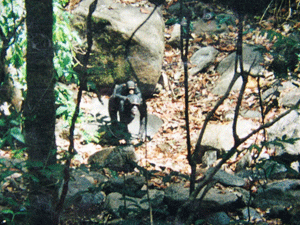
The Gashaka chimps would not have to be dimwits either if they don't display such finesse. Only an in-depth analysis of the ecology of their habitat will reveal its richness in resources. Perhaps their range is a land where milk and honey flows, so to speak, rendering the manufacture and use of tools as well as bloody hunts superfluous?
Some may judge such hypothesizing as improper anthropomorphism of animal behaviour. However, I think it is not only legitimate but necessary to assume that creatures with whom we share 99 percent of our genetic make-up have mental abilities and emotions similar to humans. And what pity, if we would lose this connection to our past forever - not to speak of the suffering which goes along with the brutal killings that happen on a daily basis and with relentless force.
Imagine the mind-boggling sums that would be poured into research and protection should intelligent beings be found on mars who felt joy or pain like we do, lived in complex societies and could communicate with us via sign-language or computer-keyboards. Ironically, mother earth harbours such creatures. And yet, we are about to allow our wild brothers and sisters to disappear into oblivion.
Destiny Chimpland
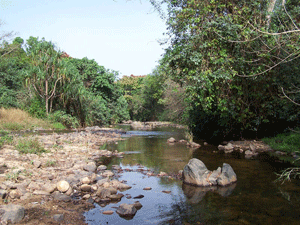
I watch the chimpanzee infant swinging boisterously through the branches. I am aware of the privilege to witness such a wonderful and yet so fragile scene.
Three, four pairs of eyes glance at us, mildly conspicuous. The party decides to move on. The chimps descend, climb over huge boulders into the murmuring bed of a creek. They knuckle-walk in single file before the undergrowth swallows them. The apes have no intention to shake us off - but we need almost half an hour to cross a terrain they master in a minute. The landscape, spectacular as it might be, will remain a challenge for us habitual bipedals - even if we succeed to fully habituate the chimpanzees to human observers.
The Nigeria National Park authorities will grant us a ten year permit to set up a long-term research project. Will it boost the ape's prospects of survival, if we put them on the map, under the magnifying glass of media attention? Last year, Nigeria's largest national park counted not even a dozen foreign visitors. Will it be good or bad, if a flourishing business of eco-tourism evolves? Will we unwittingly introduce diseases - since apes elsewhere have suffered epidemics of polio, anthrax and pneumonia? Will it slow down the rate of extinction if our project finds funding to finance research by Nigerian students, if we offer employment to locals? Will the interest of foreign scientists instill pride in the villagers about the wild kin which resides in their backyard?
I ponder such questions while knowing that they are not easily answered. But I am sure of one thing: without the interest of locals, without the ambition of researchers, without the dedication of game wardens, will these beautiful beasts disappear from the face of this planet. We owe it to them, to us and our children to not let that happen.
Salamu and I return to camp. I am exhausted, but feel deeply rewarded. A pot boils on the open fire where Luca stirs a soup. Did we see the chimpanzees? he inquires. This time I can brag. It feels as if we just made first contact with a legendary tribe.
[Originally published in: "Nigeria Parks. The Magazine for the National Parks", March 2001: 22-25]
